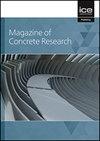High volume of slag and PP fibres in engineered cementitious composites (ECC): Microstructure and mechanical properties
IF 1.6
4区 工程技术
Q3 CONSTRUCTION & BUILDING TECHNOLOGY
引用次数: 4
Abstract
The use of engineered cementitious composite (ECC) is increasing due to its high tensile strength and ductility, however, little attention has been paid to substitutes for its ingredients. Blast furnace slag instead of fly ash and polypropylene (PP) fibres instead of polyvinyl alcohol (PVA) fibres may be considered to be appropriate alternative substitutes. However, scanty research has examined the effect of using high levels of slag and PP fibres on the mechanical properties and microstructure of ECC. Therefore, the present study aimed to produce an engineered cementitious composite with a large proportion of slag and PP fibres for achieving high strength and ductility characteristics and creating a controlled microcracking behavior under tensile stresses (i.e., strain-hardening behavior). The specimens made from the ECC thus prepared were subjected to compressive, four-point flexural, X-ray diffraction assessment (XRD), and scanning electron microscope (SEM) tests. The results showed that the slag-to-cement ratio of 0.5 in ECC led to the highest compressive strength (55.6 MPa) and modulus of rupture (7.0 MPa), while the corresponding energy absorption was fairly high. The results of XRD and SEM analyses indicated that applying the slag-to-cement ratio of 0.5 led to a homogenous cement matrix and produced the highest calcium-silicate-hydrate (C-S-H) in the ECC microstructure. Finally, to predict the load-deflection of specimens, a three-part model was proposed and verified with other available data.工程水泥基复合材料(ECC)中大量矿渣和聚丙烯纤维的微观结构和力学性能
工程水泥基复合材料(ECC)由于其高抗拉强度和延展性而越来越多地被使用,但其成分的替代品却很少受到关注。高炉矿渣代替粉煤灰和聚丙烯(PP)纤维代替聚乙烯醇(PVA)纤维可以被认为是合适的替代品。然而,很少有研究考察使用高水平矿渣和聚丙烯纤维对ECC的机械性能和微观结构的影响。因此,本研究旨在生产一种含有大量矿渣和PP纤维的工程水泥基复合材料,以实现高强度和延展性特性,并在拉伸应力下产生可控的微裂纹行为(即应变硬化行为)。对由如此制备的ECC制成的样品进行压缩、四点弯曲、X射线衍射评估(XRD)和扫描电子显微镜(SEM)测试。结果表明,ECC中矿渣与水泥的比例为0.5时,抗压强度(55.6MPa)和断裂模量(7.0MPa)最高,而相应的能量吸收相当高。XRD和SEM分析结果表明,当矿渣与水泥的比例为0.5时,水泥基体均匀,并在ECC微观结构中产生最高的硅酸钙水合物(C-S-H)。最后,为了预测试件的荷载挠度,提出了一个由三部分组成的模型,并用其他可用数据进行了验证。
本文章由计算机程序翻译,如有差异,请以英文原文为准。
求助全文
约1分钟内获得全文
求助全文
来源期刊

Magazine of Concrete Research
工程技术-材料科学:综合
CiteScore
4.60
自引率
11.10%
发文量
102
审稿时长
5 months
期刊介绍:
For concrete and other cementitious derivatives to be developed further, we need to understand the use of alternative hydraulically active materials used in combination with plain Portland Cement, sustainability and durability issues. Both fundamental and best practice issues need to be addressed.
Magazine of Concrete Research covers every aspect of concrete manufacture and behaviour from performance and evaluation of constituent materials to mix design, testing, durability, structural analysis and composite construction.
 求助内容:
求助内容: 应助结果提醒方式:
应助结果提醒方式:


